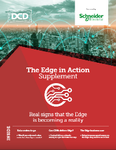When you think of an Edge data center, what comes to mind? An Equinix or Digital Realty facility in a big city? A Vapor IO container sitting next to a cell tower? A couple of racks in a Tier 3 city building? Or perhaps a ruggedized cabinet in the corner of a factory?
These are the common deployments of Edge data centers and they have one thing in common: they aren’t meant to move. That’s because the deployment is considered permanent.
However, there is a growing number of scenarios that require temporary compute and that means mobile, easily deployed and removed “data centers,” with an emphasis on being temporary deployments.
“If I were to build it once and leave it there and only use it once a year, probably not a good financial investment,” said Joseph Reele, vice president and solution architect for Schneider Electric.
“This is more along the lines of unanticipated need, like a flood or hurricane, think of natural disasters that come in that kind of wipe out that infrastructure that may be in place there or not wipe it out, but severely impact its performance.”
This is hardly new. Sun Microsystems introduced a 'data center to go' in 2006 called Project Blackbox. Its fortunes dried right up with Sun, though. These new portable data centers are much smaller than a shipping container.
How small? “When I talk small I'm talking a four blade cluster that can go into the overhead bin on a United flight,” said Bharath Ramesh, head of global product management & strategy for converged Edge systems at HPE.
“And if you have flown as much as I have, you know, I can't even put my backpack in there half the time. And I'm able to put a four-node Azure Stack HCI cluster with a commercial carry case, with the switching power and everything they need into that overhead. And that is small. I think we'd all agree,” he added.
Thanks to technological advances, that four-node cluster - the HPE EL8000 - comes with 128 cores, 80 terabytes of storage, six terabytes of memory, 10 gigabit networking, dual net switches, redundant power supplies, security and manageability.
“That's the same as our data center class in that package. So yes, you get a tremendous amount of performance in a package that small,” said Ramesh.
Portable data centers are also much more customized and tightly integrated, meaning they are built to order by the customer, said Pierluca Chiodelli, VP of Edge engineering technology at Dell Technologies. Think hyperconverged infrastructure (HCI) to an even more extreme degree.
“Internally they are just like a regular data center and the customer can choose the components to fit their needs,” he explained.
“Power delivery and density, cooling options, resiliency, security, accessibility and operations can be optimized for a given customer or IT needs. Everything they select is part of a package that is shipped fully integrated out of the factory to be put in place for the customer.”
This article appeared in our Edge Supplement. Read the whole thing here
Still nascent
Dave McCarthy, vice president in IDC's worldwide infrastructure practice, said he has definitely been hearing about this trend towards temporary data centers for a variety of situations.
“They're bringing together a bunch of data sources that they need to be able to, in real time, combine and understand what's happening, and then and then take action,” he said.
The market is still fairly new, so McCarthy had no data points to share. He said the top five vendors in the space were Schneider Electric, Dell Technologies, HPE, Vertiv, and Microsoft.
IDC sees these temporary Edge data centers in the following scenarios:
- Military/defense
- Disaster response
- Sporting events
- Media & entertainment production
- Oil & gas exploration
- Construction
Those use cases require two things: speed and value, or in industry parlance, low latency and high bandwidth, said Reele. “4K video, as an example, takes a lot of bandwidth to carry that data. So as connected things start to become more and more around us, these use cases start to develop that demand,” he said.
Extra security needed
But since they are mobile, it’s easy for them to grow legs and walk away, so to speak. So these data centers need different management than your typical Edge center, with far less trust.
“We assume that the system is compromised at all times. It's a zero trust mentality. The system wakes up and assumes that firmware is compromised. And we validate that against keys that are burned into our silicon, we call it silicon Root of Trust,” said Ramesh.
HPE uses a variety of security measures like ensuring that the system boot is metered and its data volumes are encrypted.
All of its CD drives are secure encrypted drives so if need be an admin can completely wipe the system if they think it's compromised.
“So what we're doing is creating layers of an onion,” said Ramesh. “And we're making sure that the culmination is all those layers make it really hard that even if somebody gets physical access to the system.
"So our assumption is zero trust because at the Edge, there is no access control data center protecting your system, it has to be secure, by default.”
But Jamie Bourassa, VP of Edge computing at Schneider, says he’s seen these portable data centers in mobile rigs, which are really a central command post with desks, screens, communication links, and inside that rig is a miniature data center. Rather than a stand-alone, unit, the portable data center is part of a larger mobile unit and there is no stealing the compute without taking the whole rig, an unlikely event.
“As I think through the different use cases, say for concerts, you do see people bringing in very advanced video systems that are driving a tremendous amount of content and audio. They're also collecting information about the people that are there. And those are use cases where the data center is really consolidated around the actual rig for that particular vendor or that particular media company who's deploying it,” he said.
Market is growing
IDC definitely sees growth in this area, it’s just so early there aren’t a lot of numbers, McCarthy said. But the market is growing and expanding into new territories.
“We're seeing some of this show up also in like education. I know that I've seen situations and like, like oil and gas, especially on the exploration side. I think there are lots of situations where, whether it's just the temporary nature of it, or offering augmented capacity, that we will continue to see it grow,” he said.
Ramesh predicts that the next stage will be high performance computing and supercomputers in a box, because the growth of data is at the Edge is enormous, with potentially as many as 55 billion connected Edge devices by 2022.
“That's a ginormous amount of data. And that data gravity is going to create a demand for Edge compute, that's of the enterprise variety, not Edge compute that's in your phone or in your fitness tracker, because that enterprise compute is what's going to help businesses create new business models, or just transform the efficiency of what they're doing,” he said.
Chiodelli thinks demand will increase as connectivity gets better and Edge devices allow for data to be captured faster and more effectively. “When data can be captured and used in real time, customers will want to continue to improve the performance of their Edge sites to get even more value from this and the need for the localized ability to house and operate compute, storage and networking will evolve,” he said.




